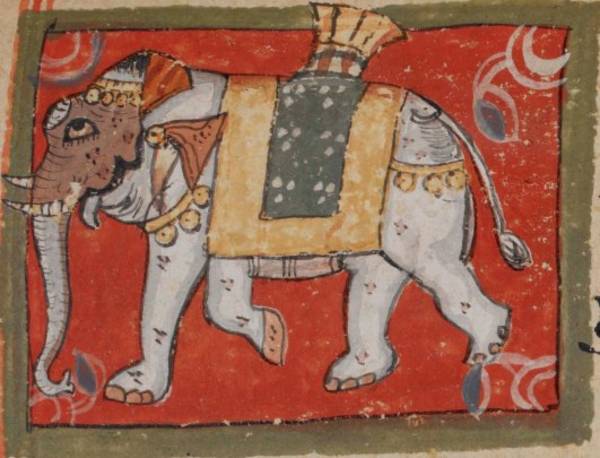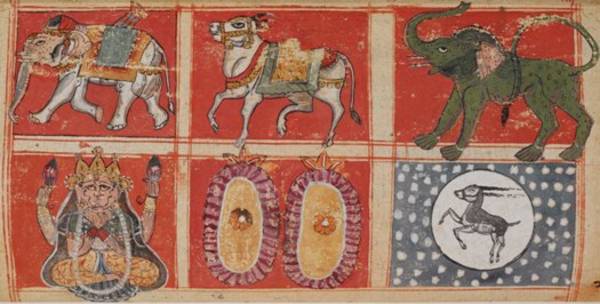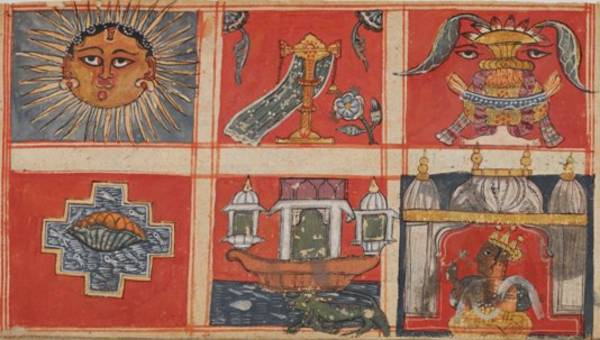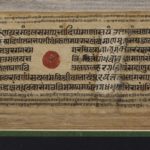Article: Dreams
Jains’ interest in dreams is connected with their general interest in the field of omens and predictions. Dreams have such importance in the Jain literary, pictorial and religious traditions because the concept is closely connected with those they respect most – the Jinas.
The most famous dreams in Jain belief are those experienced by the woman pregnant with the new Jina. These auspicious dreams are a key feature of the Kalpa-sūtra, a significant text for Śvetāmbara Jains. They also play an important role in celebrations of the annual festival of Paryuṣaṇ, in which the Kalpa-sūtra has a central position.
Depictions of these auspicious dreams are common in various artistic media. Representations of the dreams form striking decorative elements of many Jain temples while Śvetāmbara Jains create ornate manuscript covers and invitation scrolls featuring the dreams. The symbols of these dreams have become auspicious emblems for Śvetāmbaras and are often used as artistic motifs in their own right.
Dream analysis and interpretation
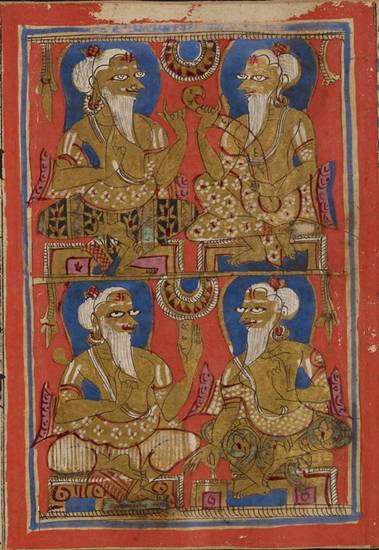
Interpreting dreams
Image by British Library © CC0 1.0 (Creative Commons Public Domain)
Interpreting dreams is forbidden to the average monk. Nevertheless, as they could not remain ignorant of any type of knowledge, leading Jain religious teachers have contributed to this area of knowledge in two areas. These are by including passages about dreams in Jain scriptures, commentaries and narrative writings and by copying or quoting non-Jain works dealing with dreams.
Firstly, the Śvetāmbara canonical scriptures contain some elements dealing with dreams.
For example, in the Vyākhyāprajñapti, the fifth book of the canon, XVI.6 contains an important passage on the nature of dreams, in which:
- dreaming is associated with neither sleep nor being awake, but a state in between the two
- dreams are classified according to the time of night they are experienced, with those at the end of the night believed to be very spiritually beneficial.
In another instance, in the Sthānānga-sūtra, X.3 discusses ten dreams in some detail, namely:
- listing the ten dreams the Jina Mahāvīra sees before he reaches omniscience
- describing their meanings.
Secondly, some early teachers of the Jain tradition are credited with deep knowledge of dreams. A well-known example is Kālaka in the Kalpa-sūtra. Other examples see monks:
- writing about dreams in larger works on the interpretation of omens, such as the Angavijjā in Prakrit and the Bhadrabāhusaṃhitā in Sanskrit
- composing various short treatises on dreams – such as Svapna-pradīpa and Svapna-saptati
- frequently including teachings about dreams in their narrative works or in commentaries on the scriptures
- copying and thus guaranteeing the circulation of non-Jain treatises dealing with the subject, such as Jagaddeva’s 12th-century Svapna-cintāmaṇi, or quoting from it in their own works.
Most of the works devoted to dream analysis are still awaiting publication, possibly because dream interpretation is not usually permitted. When passing on teachings about dreams, mendicants may follow the Āyurvedic analysis in considering that dreams are linked to the individual’s unique biology and the proportions of the elements that make up his body. For instance, in the Tarangavaī, an early Jain novel in Prakrit, the heroine’s father explains the dreams she had the night before and gives examples of shapes that are bad or good dreams.
Jain narrative works provide several examples of dreams and interpretation in practice, like in the Tarangavaī. The dreamer does not usually interpret his dream himself, with a specialist or person close to him interpreting it for him instead. Therefore the dream needs to be communicated. Such narrative scenes, however, are found everywhere in Indian literature, Jain or not.
Function of dreams in religious contexts
Dreams play an important part in stories of the origin of certain religious images and usually follow the same pattern. Firstly, a devotee has a dream during the night in which a god or a Jina talks to him, telling that an image is buried or hidden somewhere and he has to bring it to light. The following day the devotee unearths the image as instructed. In the last stage a new temple is created on the site of the find.
This motif is frequently found in the semi-historical semi-legendary works of medieval Jain literature known as prabandhas. It also features in the Vividha-tīrtha-kalpa written by the monk Jinaprabha-sūri in the 14th century, which is an account of many Jain sacred places. Modern reports in booklets that discuss a local Jina image continue this tradition.
The Prince Śreyāṃsa story is well known in the Jain tradition. He was the first person in the world to be able to give proper alms to the first Jina, Ṛṣabhanātha or Lord Ṛṣabha, who had been fasting for a full year. The Jina’s visit to his house was announced to him through a dream, although he could not understand the meaning of the dream by himself.
These are only a few examples which show how dreams are connected to the faith and how Jains think of their role.
An instance of dreams announcing a disaster is that of the eight dreams of Puṇyapāla, a contemporary of Mahāvīra. The dreams feature:
- an elephant
- a monkey
- a fig tree
- a crow
- a lion
- a lotus
- a seed
- a jug.
Some of these items are not negative in themselves, and are among those predicting the birth of a future Jina. In this context, however, Mahāvīra explains them as predicting the progressive disappearance of people who live a pious life and know the scriptures.
Dreams and Jain Universal History
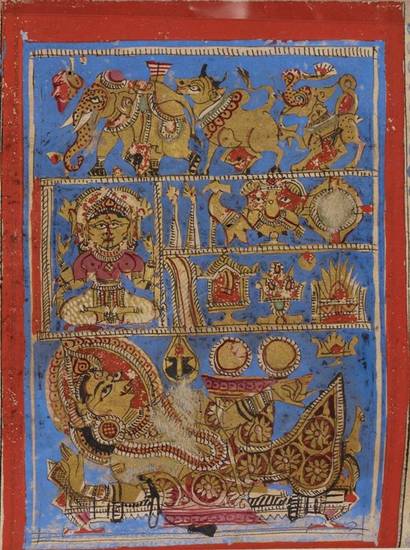
Devānandā’s 14 dreams
Image by British Library © CC0 1.0 (Creative Commons Public Domain)
In the Jain tradition dreams have come to occupy a special place because they are connected with the births of the Jinas and the other types of illustrious people that form Jain Universal History or mythology. These are ‘universal monarchs’ or cakravartins, Baladevas and Vāsudevas. The mothers of children who will belong to one of these groups see a certain number of dreams. Or, as some of the sources write, these dreams ‘enter their mouths’.
According to the Kalpa-sūtra, a source which has become the standard at least for the Śvetāmbaras, the treatises distinguish between 42 dreams of a common type and 30 great dreams (Jacobi 1895: 246). Only the great dreams are relevant here and the connection is summarised in the table.
Kalpa-sūtra and the 14 dreams
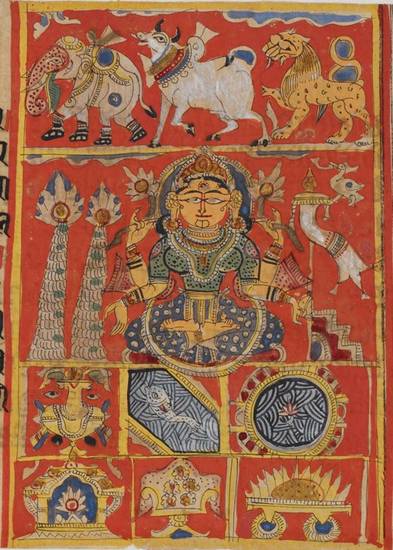
Dreams of an expectant mother
Image by British Library © CC0 1.0 (Creative Commons Public Domain)
In the Śvetāmbara tradition, the first detailed description of each of the 14 dreams is found in the Kalpa-sūtra. This is a sacred book written in Ardhamāgadhī Prakrit, the first part of which narrates the lives of the 24 Jinas, starting with that of Mahāvīra.
The dreams of Mahāvīra’s two mothers are given in considerable detail four times in this tale, as follows:
- When at first the brahmin lady Devānandā is pregnant with the future Mahāvīra, she has the 14 dreams announcing that her child will become a Tīrthaṃkara.
- When the embryo has been transferred to Triśalā, a lady from the kṣatriya caste, in which a future Jina must be born, she has the same dreams.
- After Triśalā awakes from these dreams, she tells her husband, who understands that they predict the birth of a boy who will be the glory of the family. As the night has not yet ended, Triśalā goes back to bed but decides to stay awake. She does not want possible bad dreams to counteract these auspicious dreams so she listens to good religious stories (Jacobi 1895: 240).
- The next morning, the king orders the hall of audience to be ceremoniously prepared and readies himself to welcome the dream-interpreters for whom he has sent. They tell him that the 14 dreams are experienced by mothers of universal monarchs or Jinas (Jacobi 1895: 246).
The mothers of three other Jinas are described as having the same dreams but they all experience the dream of the bull first, not second. These Jinas are:
- Pārśvanātha or Lord Pārśva
- Ariṣṭaneminātha or Lord Ariṣṭanemi
- Ṛṣabhanātha or Lord Ṛṣabha.
Together with Mahāvīra, these individuals are the four most popular Jinas. The text does not go into detail about the dreams of the mothers of the other 20 Jinas.
Fourteen dreams in the text
When the brahmin lady Devānandā has her 14 dreams, they are listed in a stanza.
When Triśalā has the same dreams the identical stanza is used, but is followed by a description of each of the dreams.
This description is in sophisticated prose. It features extremely long descriptive compounds, characteristic of old Indian poetical style. The physical appearance of the animals, the goddess Śrī and the various objects is a focus of description. There are detailed comparisons, for example when describing colours, along with rich vocabulary.
Other devices used in this lyrical style include listing and meticulous description. An example of the first is the list of a large variety of flowers in the description of the garland in dream number 5 while the birds of the lotus pond in dream number 11 are listed in detail.
Instances of the second device include the lively nature of the animal portraits and the account of Śrī. The goddess’s body is described in the traditional fashion suitable for non-human beings, which goes from the feet to the head. She is said to be seated on a lotus while elephants sprinkle her with water using their trunks. This element is often shown in iconography.
Some scholars assert that the mention of a ‘garland of dīnāra-coins’ as an ornament around Śrī’s neck suggests that the dream section dates from a period when this type of coin became popular in India. If so, it is perhaps later than the rest of the text (Shah 1987: 18).
On the other hand, it has been shown that the prose description contains some archaic stylistic features. The main one is some compounds that are written in metrical prose (Jacobi 1885).
Fourteen dreams in illustrations
The dreams of the pregnant woman are represented in several stock ways in manuscripts of the Kalpa-sūtra. The artist may use all of them or choose a few.
A common method is to show the pregnant mother lying on her bed, with the 14 dreams pictured in small size at the top, arranged in one or several rows. In the case of Mahāvīra, both his mothers, Devānandā and Triśalā, have the dreams. The dreams can thus be shown once or twice in the same manuscript, as in these two folios in the British Library. The traditional sequence of dreams may be rearranged, depending on the space available.
Painters sometimes copy the scene for the sections dealing with the births of Pārśvanātha or Lord Pārśva, Neminātha or Lord Nemi and R̥ṣabhanātha or Lord Ṛṣabha. This is not found frequently, however, so it seems as if the 14 dreams have always been closely connected with Mahāvīra alone.
When portraying the 14 dreams, painters might show them in a group or individually. If the dreams are illustrated as a group, either they are all the same size or the fourth one, the goddess Śrī, is much larger than the others.
Depicting each dream individually is less common because it uses a lot of space. A rare instance is provided by the manuscript ‘Hg’, shown in W. Norman Brown (1934: figures 21 to 33). Here 13 paintings are devoted to the 14 dreams, with the flag and the pitcher in one illustration. But this manuscript contains 64 miniatures in total, which is unusually high.
Sometimes several of the dreams are shown in successive small vignettes. This manuscript held in the British Library under the shelfmark Or. 13455 has individual pages featuring the:
Another comparatively rare artistic decision is where the illustration of the auspicious dreams is spread over successive pages. This example found in the British Library under the shelfmark of Or. 13701 shows on different pages the:
When only one dream is represented individually, it is always Śrī. An explanation could be that as a female deity her protective role is primary, and she is more recognisable than objects.
Dream-interpreters
The Kalpa-sūtra text does not give any information about the social status or the origin of the dream-interpreters. Their ceremonious welcome only indicates that they are important.
In paintings of the dream-interpreters they are usually represented as old men with white beards. They are depicted with the same type of costume and appearance as brahmins in Jain manuscript illustration. In most scenes, two interpreters are shown in discussion, sometimes holding manuscripts and writing implements in their hands. These are the treatises from which they draw their knowledge on the subject.
Dreams in Paryuṣaṇ
The 14 dreams play a specific part in the festival of Paryuṣaṇ, which is celebrated towards the end of the rainy season. The dreams are involved on the fifth day of the festival, which lasts seven days. On that day, the monks read aloud or narrate the portion of the Kalpa-sūtra dealing with Mahāvīra’s birth to the lay community gathered in the ascetics’ dwelling-hall.
In addition, the dreams are displayed to the congregation in the form of silver models, which are put on trays or hung from the ceiling. The Śvetāmbara Mūrti-pūjaka Jains organise auctions to choose who gains the right to perform religious acts. In this case, the winner has the right ‘to swing the dream, to garland it with āsopalav leaves or flowers, to garland it with [a] gold or silver necklace, and to place the dream on a table in the center of the upāśray‘ (Cort 2001: 155; 153–157 for full description and two photographs).
Displaying the dreams as sacred objects, making offerings to them and also staging the dreams as tableaux are important components of celebrating Paryuṣaṇ that involve the active participation of the Jain lay communities. For example, the 2005 Paryuṣaṇ celebration by Oswal Jains from north-west London demonstrates some of these practices.
Dreams in the Jain temple
More generally, the 14 dreams of the Śvetāmbara or the 16 dreams of the Digambara are a central part of Jain religious life. They are a commonplace sight in many temples in the form of:
- bas-reliefs or sculptures on temple walls
- metal objects that are free-standing, or on wooden and metal stools and platters used for making offerings (an example is Plate III in Johnson 1931)
- mural paintings of all periods, including contemporary works, in Śvetāmbara or Digambara temples (Hegewald 2009: figures 11 and 266).
There are numerous instances of classical sculptures from the medieval period, such as the:
- exquisite panel showing Triśalā on her bed fanned by attendants, with the 14 dreams above her in the form of an arch in the Pañcāsara Pārśvanātha Temple at Patan, Gujarat (good photograph in Hegewald 2009: figure 12)
- architrave with the 14 dreams in the hall of the main shrine in the Kharataravasahi Caumukha at Delvada at Mount Abu, Rajasthan
- 14 dreams with a Jina’s mother form part of a panel on the fourth rectangular ceiling in the Mahāvīra temple at Kumbharia, North Gujarat (Dhaky, Moorti 2001: figure 59)
- 14 dreams with a Jina’s mother form part of a panel on the seventh rectangular ceiling in the Mahāvīra temple at Kumbharia, North Gujarat (Dhaky, Moorti 2001: figure 62)
- 14 dreams with a Jina’s mother above the door lintel of the Pārśvanātha temple at Kumbharia, North Gujarat (Dhaky, Moorti 2001: figure 134)
- 14 dreams form part of a ceiling panel portraying the life of Pārśvanātha or Lord Pārśva at Kumbharia, North Gujarat (reproduced, for instance, in Shah 1955: figure 83)
- wooden panel presenting the 14 dreams at Patan (Shah 1955: figure 87).
- door frame of a cell in the Śāntinātha shrine and other shrines at Khajuraho (Shah 1987: 18).
Śvetāmbara auspicious symbols
The Kalpa-sūtra manuscripts use the 14 auspicious dreams as the main topic of illustration. In line with this approach, the Śvetāmbaras have developed the theme of the dreams into an auspicious symbol or decorative motif that is independent of any textual connection.
Manuscript covers
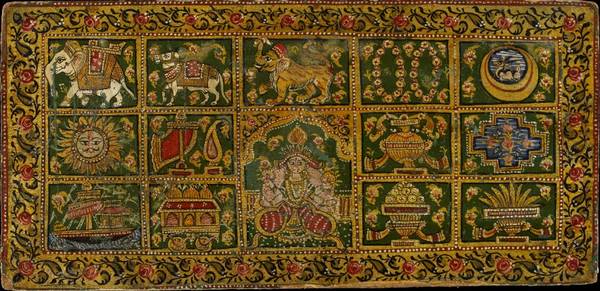
Fourteen auspicious dreams
Image by Victoria and Albert Museum © V&A Images/Victoria and Albert Museum, London
Together with the eight auspicious symbols, the 14 dreams have proven one of the favourite themes on manuscript covers – called pāṭhuṃ in Gujarati – since the 18th century.
There are two fine examples of manuscript covers depicting the 14 dreams held in the Victoria and Albert Museum in London. The Ethnographic Museum in Antwerp has a good selection of such covers. They are made of either cardboard covered with cloth or painted wood. They demonstrate features of the pictorial style of the regions where they were made
See pages 101 to 103 of Van Alphen 2000 for photographs and Appendix IV of Shah 1978 for references to other covers. The 1978 book Treasures of Jaina Bhandāras contains a photograph of a 20th-century cover embroidered with tiny pearls on page LXX. This is found on D-70 of the PDF version that can be downloaded from the Jain eLibrary once a free account is created.
For another wooden book-cover showing episodes from the life of the 23rd Jina, Pārśvanātha or Lord Pārśva, including the dreams, see pages 2 to 12 of volume V of the Journal of the Indian Society of Oriental Art.
Paintings in invitation scrolls

Śrī and elephants
Image by British Library © CC0 1.0 (Creative Commons Public Domain)
Invitation scrolls or vijñapti-patras are formal letters inviting a leading monk of a certain monastic group to spend the next rainy season in a certain place. A community of lay Jains sends these letters, the local merchants often sending these on behalf of the wider group.
These invitations take the form of long scrolls with text and paintings. The text consists of poetical description and praises of mendicants and the Jinas. Generally, the opening paintings are the 14 dreams or the eight auspicious symbols. The tradition of painting the dreams in invitation scrolls can be explained by the connection with the rainy season and thus the major Śvetāmbara festival of Paryuṣaṇ.
An example of an invitation scroll is in the Jain collection at the British Library, under the shelfmark of Or. 16192.
These invitation letters are found in Rajasthan and Gujarat from the 17th century onwards. They are a speciality of the Śvetāmbara Kharatara-gaccha and Tapā-gaccha communities.
Reading
- ‘How to Sleep? What to Dream?: Sleep and Dreams Dos and Don’ts in the Jain Tradition’
Nalini Balbir - The Indian Night: Sleep and Dreams in Indian Culture
edited by Claudine Bautze-Picron
Rupa & Co; New Delhi, India; 2009
- The Indian Night: Sleep and Dreams in Indian Culture
Claudine Bautze-Picron - Rupa & Co; New Delhi, India; 2009
- ‘The Great Men of Jainism in Utero: A Survey’
Eva De Clercq - Imagining the Fetus: The Unborn in Myth, Religion, and Culture
edited by Vanessa R. Sasson and Jane Marie Law
Oxford University Press; Oxford, England UK; 2009
- ‘The Conqueror’s Life in Jaina Painting: Explicitur Reductio Haec Artis ad Theologiam’
Anand K. Coomaraswamy - Essays on Jaina Art
edited by Richard J. Cohen
Collected Works of Dr. Ananda Coomaraswamy series; volume 15
Indira Gandhi National Centre for the Arts and Manohar; New Delhi, India; 2003
- Jains in the World: Religious Values and Ideology in India
John E. Cort - Oxford University Press USA; New York, USA; 2001
- The Temples at Kumbhārīyā
M. A. Dhaky and U. S. Moorti - American Institute of Indian Studies and Lalbhai Dalpatbhai Institute of Indology; New Delhi and Ahmedabad, Gujarat, India; 2001
- Jaina Temple Architecture in India: The Development of a Distinct Language in Space and Ritual
Julia A. B. Hegewald - Monographien zur Indischen Archäologie, Kunst und Philologie series; volume 19
Stiftung Ernst Waldschmidt, G+H Verlag; Berlin, Germany; 2009
- ‘Indische Hypermetra und hypermetrische Texte’
Hermann Jacobi - Indische Studien
edited by Albrecht Weber
Deutsche Morgenländische Gesellschaft series; volume 17
F. Dümmler (Berlin), F. A. Brockhaus (Leipzig); Berlin and Leipzig, Germany; 1885
- 'The Kalpa Sûtra of Bhadrabâhu'
Bhadrabāhu - translated and edited by Hermann Jacobi
Abhandlungen für die Kunde des Morgenlandes
Deutschen Morgenländischen Gesellschaft series; series editor Otto Loth; volume VII: 1
F. A. Brockhaus; Leipzig, Saxony, Germany; 1879
- ‘Common Dream and its Interpretation according to Indian Narrative Material’
Jean-Pierre Osier - The Indian Night: Sleep and Dreams in Indian Culture
edited by Claudine Bautze-Picron
Rupa & Co; New Delhi, India; 2009
- Studies in Jaina Art
Umakant Premanand Shah - Abhinav Publications; Banaras, Uttar Pradesh, India; 1955
- Treasures of Jaina Bhandāras
Umakant Premanand Shah - L. D. series; volume 69
L. D. Institute of Indology; Ahmedabad, Gujarat, India; 1978
- Steps to Liberation: 2500 Years of Jain Art and Religion
Jan van Alphen - Etnografisch Museum Antwerpen; Antwerp, Belgium; 2000
Links
- Mahāvīr Janam Divas celebration
-
This YouTube slideshow of the celebrations of Paryuṣaṇ in Melbourne, Australia in 2010 illustrates some of the features of the eight-day long festival. Sculptures of the 14 auspicious dreams experienced by Mahāvīra’s mother are suspended from the ceiling on the fifth day of Paryuṣaṇ – Mahāvīr Janam Divas, which celebrates the birth of Mahāvīra, the 24th Jina. The sculptures are venerated in turn by all the festival participants, sometimes by being held to the crown of the head, seat of spirituality in Indian culture. Then auctions – bolī – are held to decide who should perform various ceremonies. The most important and expensive auction is over the right to take home the image of the infant Mahāvīra for the last three days of the festival. Everyone can rock the cradle holding the idol of the baby Jina, which takes pride of place in the display.
- Dreams of Triśalā
-
Jainworld.com provides pictures and explanations of the dreams of Queen Triśalā. Women carrying babies who grow up to become Jinas all experience auspicious dreams, which signal the great spiritual leadership of their children. The Digambara sect specifies 16 dreams while the Śvetāmbaras have14 dreams.
- +
- aAbhavya
- aAbhinandana
- aAbhiṣeka
- aĀcāra
- aĀcārāṅga-sūtra
- aĀcārya
- aAchalbhrata
- aAḍhāī-dvīpa
- aAdharma
- aAdho-loka
- aAdhyayana
- aAdvaita Vedānta
- aĀgama
- aAghātīya
- aAghātīya-karman
- aAgnibhuti
- aAgra
- aĀhāra
- aAhiṃsā
- aAhimsa Day
- aAjita
- aAjīva
- aAkampit
- aĀkāśa
- aAkbar the Great
- aAkṣaya-tṛtīyā
- aAlauddin Khalji
- aAlbert Einstein
- aAllah
- aAlms
- aĀlocanā
- aAloka-ākāśa
- aAmāri
- aAmbikā or Kūṣmāṇḍinī
- aAnagāra
- aAnanta
- aAnarthadaṇḍa
- aAnaśana
- aAnekānta-vāda
- aAṅga
- aAniconism
- aAnojjā
- aAntarāla
- aAntarāya-karma
- aAṇu
- aAṇu-vrata
- aAnukampā
- aAnuprekṣā
- aAnusvāra
- aApabhraṃśa
- aAparigraha
- aAra
- aĀrambha
- aĀrambhaja
- aĀratī
- aArdhamāgadhī Prākrit
- aArhaṃ
- aArhat
- aArśana-āvaraṇīya-karma
- aĀrta-dhyāna
- aĀryikā
- aĀryikā Jñānamati
- aĀśātanā
- aĀścarya
- aAscetic
- aAsceticism
- aAshram
- aAspiration
- aĀsrava
- aAṣṭa-maṅgala
- aAṣṭāpada
- aAstikāya
- aAstrolabe
- aAsura
- aAtheism
- aAticāra
- aAtiśayakṣetra
- aAtithisaṃvibhāgavrata
- aĀtma-vāda
- aĀtman
- aAuṃ
- aAurangzeb
- aAuspicious
- aAusterity
- aAvadhāna
- aAvadhi-jñāna
- aĀvaraṇī-yakarman
- aAvasarpiṇī
- aAvatāra
- aAvidyā
- aAxiom
- aĀyāga-paṭa
- aĀyambil
- aĀyu-karma
- aĀyurveda
- bBabur
- bBāhubali
- bBaladeva
- bBālāvabodha
- bBandha
- bBasadi
- bBazaar
- bBhadrankarvijay
- bBhagavant
- bBhaktāmara-stotra
- bBhakti
- bBhale
- bBharata
- bBhāṣā
- bBhāṣya
- bBhaṭṭāraka
- bBhāva
- bBhāva-pūjā
- bBhāvanā
- bBhavana-vāsin
- bBhavya
- bBhavyatva
- bBhaya
- bBhoga-bhūmi
- bBhogopabhoga
- bBodhi
- bBollywood
- bBrahmā
- bBrahma-deva
- bBrahmacārī
- bBrāhmaṇa
- bBraj Bhāṣā
- bBright fortnight
- bBritish Raj
- bBuddha
- bBuddhi-sagar
- bBuddhism
- bBuddhist
- cCaitya
- cCaityavāsin
- cCakravartin
- cCakreśvarī
- cCāmara
- cCandanā
- cCandragupta
- cCandraprabha
- cCanon
- cCāritra
- cCāritramohanīya-karman
- cCarũrī
- cCaste
- cCaturvidha-saṅgha
- cCaturviṃśati-stava
- cCāturyāma
- cCE
- cCelibacy
- cCha
- cChadmastha
- cChastity
- cCheda-sūtra
- cChristian
- cChristianity
- cClergy
- cCloning
- cColophon
- cCommentary
- cConch
- cConfession
- cCongregation
- cConsecration
- cCosmology
- cCremation
- cCrore
- cCult
- cCūrṇi
- dDādā-guru
- dDalit
- dDāna
- dDaṇḍa
- dDark fortnight
- dDarśana
- dDarśanamohanī-yakarman
- dDaśa-lakṣaṇa-parvan
- dDeity
- dDelhi Sultanate
- dDerāsar
- dDeśāvakāśika-vrata
- dDetachment
- dDevanāgarī
- dDevānandā
- dDevarddhi-gani
- dDevotee
- dDhamal
- dDhanuṣ
- dDhāra
- dDharma
- dDharma-dhyāna
- dDharma-sāgara
- dDharmastikaya
- dDhātakīkhaṇḍa
- dDholak
- dDhyāna
- dDiaspora
- dDig-vrata
- dDigambara
- dDīkṣā
- dDisciple
- dDīvālī
- dDivya-dhvani
- dDNA
- dDoctrine
- dDogma
- dDonor
- dDoṣa
- dDravya
- dDravya-pūjā
- dDrone
- dDuṣamā
- dDuṣamā-duṣamā
- dDuṣamā-suṣamā
- dDveṣa
- dDvīpa
- eEast India Company
- eEightfold Path
- eEkānta-vāda
- eEkendriya
- eElder
- eElders
- eEschatology
- eEtc up to
- fFarmān
- fFast
- fFatehpur Sikri
- fFestival
- fFestschrift
- fFiruz Shah
- fFly-Whisks
- fFolio
- fFour Noble Truths
- gGaccha
- gGaṇa
- gGaṇadhara
- gGanadharavada
- gGaṇeśa
- gGaṇin
- gGarba
- gGarbha
- gGarbha-gṛha
- gGaruḍa
- gGati
- gGene
- gGenomics
- gGhātī-yakarman
- gGhātīya
- gGhaznavid
- gGhiyasuddin Tughlaq
- gGhurid
- gGloss
- gGotra-karma
- gGujarāt
- gGujarati
- gGuṇa
- gGuṇa-sthāna
- gGuṇa-vrata
- gGupti
- gGuru
- gGuruṇī
- hHagiography
- hHajj
- hHaṃsa
- hHaribhadra
- hHariṇaigameṣin
- hHasta
- hHeresy
- hHiṃsā
- hHindi
- hHindu
- hHinduism
- hHīravijaya
- hHoroscope
- hHrīṃ
- hHumayun
- hHymn
- iIconoclasm
- iIconography
- iIdol
- iIndian Independence
- iIndology
- iIndra
- iIndrabhūti Gautama
- iIndriya
- iInitiation
- iIntercession
- iInvocation
- iIQ
- iIslam
- iIslamicate
- iIṣṭadevatā
- iĪśvara
- jJagat
- jJahangir
- jJain
- jJaina Devanāgarī
- jJaina Śaurasenī
- jJaina-dharma
- jJainaśāsana
- jJainness
- jJaisalmer
- jJamāli
- jJambū-dvīpa
- jJames Burgess
- jJanma
- jJanma-kalyāṇa
- jJarā
- jJāti
- jJina
- jJina-āgama
- jJina-bhavana
- jJina-bimba
- jJina-mātā
- jJinacandra-sūri
- jJinadatta
- jJinaprabha
- jJīva
- jJñāna
- jJñāna-āvaraṇīya-karma
- jJñāna-āvarṇiya
- jJñānsundar
- jJyotiṣka
- kKāla
- kKālakācārya-kathā
- kKālidāsa
- kKalpa-sūtra
- kKalpa-vṛkṣa
- kKalyāṇaka
- kKalyanvijay
- kKamaṇḍalu
- kKamaṭha
- kKarma
- kKarma-bhūmi
- kKarma-grantha
- kKarma-prakṛti
- kKarma-vāda
- kKarmon
- kKarnataka
- kKaṣāya
- kKathā
- kKāvya
- kKāya
- kKāyotsarga
- kKeśa-loca
- kKetu
- kKevala-jñāna
- kKevalin
- kKhalji
- kKharatara-gaccha
- kKnowledge
- kKriyā
- kKriyā-vāda
- kKṛṣṇa
- kKṣamā-śramaṇa
- kKṣapakaśreṇi
- kKṣatriya
- kKṣullaka
- kKulakara
- kKundakunda
- kKunthu
- lLabdhi
- lLaity
- lLakh
- lLāñchana
- lLands of Action
- lLaukāntika
- lLavaṇa-samudra
- lLeśyā
- lLiṅga
- lLinguistics
- lLoka
- lLoka-ākāśa
- lLoka-puruṣa
- lLoka-vāda
- lLotus
- lLotus lake
- mMadhya-loka
- mMahā-videha
- mMahā-vrata
- mMahābhārata
- mMahāmastakābhiṣeka
- mMāhārāṣṭra
- mMāhārāṣṭrī Prākrit
- mMahattarā Yākinī
- mMahāvīr Jayantī
- mMahāvīra
- mMakāra
- mMakkhali Gośāla
- mMalli
- mMāna-stambha
- mManaḥ-paryāya-jñāna
- mMaṇḍala
- mMaṇḍapa
- mMandit
- mMaṅgala
- mMantra
- mMantras
- mManuṣya-loka
- mMarāṭhī
- mMārgaṇā
- mMartyr
- mMarudevī
- mMaṭha
- mMati-jñāna
- mMauryaputra
- mMecca
- mMendicant lineage
- mMetarya
- mMiracle
- mMithyādṛṣṭi
- mMohandas Gandhi
- mMohanīya-karma
- mMokṣa
- mMonastic order
- mMonasticism
- mMonk
- mMonotheism
- mMosque
- mMount Meru
- mMount Sammeta
- mMṛgāvatī
- mMughal
- mMuhammad
- mMuhammad bin Tughlaq
- mMuhpattī
- mMūla-sūtra
- mMūlaguṇa
- mMumbaī
- mMuni
- mMunisuvrata
- mMurad Bakhsh
- mMūrti-pūjaka
- mMuslim
- mMysticism
- nNābhi
- nNāga-kal
- nNāgapurīya Tapā-gaccha
- nNāgarī
- nNāma-karma
- nNamaskāra-mantra
- nNami
- nNandīśvara-dvīpa
- nNandivardhana
- nNandyāvarta
- nNāraka
- nNāraki
- nNasalisation
- nNātha
- nNavrātrī
- nNaya-vāda
- nNemi
- nNidāna
- nniggaṃthāṇa vā 2
- nniggaṃtho vā 2
- nNigoda
- nNihnava
- nNikṣepa
- nNirgrantha
- nNirjarā
- nNirvāṇa
- nNiryukti
- nNiṣidhi
- nNitya
- nNiyati
- nNo-kaṣāya
- nNudity
- nNun
- oOcean of milk
- oOmniscience
- oOrdination
- ppa°
- pPadmaprabha
- pPadmāsana
- pPadmāvatī
- pPādukā
- pPalanquin
- pPalette
- pPañca-muṣṭi
- pPāṇḍava
- pPaṇḍit
- pPandit Dalsukh D. Malvania
- pPandit Sukhlalji
- pPāṇipātra
- pPāpa
- pParamātman
- pParameṣṭhin
- pPāraṇā
- pParigraha
- pPariṇāma
- pParīṣaha
- pParokṣa
- pPārśva
- pPārśvanātha
- pParyāya
- pParyuṣaṇ
- pPaṭa
- pPatan
- pPātra
- pPenance
- pPersian
- pPhala
- pPhilology
- pPicchikā
- pPilgrimage
- pPīr
- pPolymath
- pPoṣadha
- pPossession
- pPothī
- pPrabhas
- pPradakṣiṇā
- pPradeśa
- pPrākāra
- pPrakīrṇaka-sūtra
- pPrākrit
- pPramāda
- pPramukhā
- pPrati-vāsudeva
- pPratikramaṇa
- pPratimā
- pPratiṣṭhā
- pPratyākhyāna
- pPratyakṣa
- pPravacana
- pPrāyaścitta
- pPrayer
- pPre-modern
- pPreach
- pPredestination
- pProtestant
- pProvenance
- pPudgala
- pPūjā
- pPujārī
- pPukharavara-dvīpa
- pPuṇya
- pPūrva
- pPuṣkara-dvīpa
- pPuṣpadanta
- pPyre
- qQur’an
- rRāga
- rRāhu
- rRainy season
- rRajasthan
- rRajasthani
- rRājimatī
- rRajoharaṇa
- rRajput
- rRāma
- rRāmāyaṇa
- rRangoli
- rRās-garbā
- rRasa
- rRathanemi
- rRatna-traya
- rRātri-bhojana
- rRaudra-dhyāna
- rRecto
- rRelic
- rRenunciation
- rRetroflex
- rRevatī
- %Ṛg-veda
- rRite
- rRosary
- %Ṛṣabha
- %Ṛṣabhanātha
- rRupee
- sSaciyā Mātā
- sSādhu
- sSādhvī
- sSāgāra
- sSaint
- sŚaivaism
- sŚaka-saṃvat
- sSallekhanā
- sŚalya
- sSamacatuṣṭha
- sSamādhimaraṇa
- sSamaṇi
- sSāmarambha
- sSamavasaraṇa
- sSāmāyika
- sSaṃbhava
- sSamiti
- sSaṃjñā
- sSaṃkalpaja
- sSaṃsāra
- sSamudghāta
- sSaṃvara
- sSaṃvega
- sSamyak-cāritra
- sSamyak-darśana
- sSamyak-jñāna
- sSamyaktva
- sSaṃyama
- sSanctuary
- sSandalwood
- sSaṇgha
- sSanskrit
- sSant
- sŚānti
- sSapta-bhaṅgi-naya
- sSārambha
- sSarasvatī
- sSarvajña
- sSāsan-devi
- sŚāsana-devatā
- sŚāstra
- %Ṣaṭ-jīvanikāya
- sSatī
- sSatīmātā
- sSatya
- sSchism
- sScribe
- sScripture
- sSect
- sSecularism
- sŚenāī
- sSermon
- sŚeṣavatī
- sSevā
- sSeven fields of donation
- sShah Jahan
- sShantidas Jhaveri
- sShrine
- sSiddha
- sSiddha-śilā
- sSiddhacakra or Navadevatā
- sSiddhānta
- sSiddhārtha
- sSiddhi
- sSikh
- sSikhism
- sŚikṣā-vrata
- sŚīla
- sSin
- sSindh
- sŚītala
- sŚiva
- sSkandha
- sSomanatha
- sŚraddhā
- sŚramaṇa
- sŚrāvaka
- sŚrāvakācāra
- sŚrāvikā
- sŚreyāṃsa
- sŚrī
- sŚrīvatsa
- sŚruta-jñāna
- sŚruta-pañcamī
- sSthānaka-vāsin
- sSthāpanācārya
- sSthāvara
- sSthavira
- sSthiti
- sStrīmukti
- sStūpa
- sSubcontinent
- sSudarshana
- sŚuddhi
- sSudharma
- sŚūdra
- sSufism
- sSukha
- sŚukla-dhyāna
- sSulasā
- sSultan
- sSumati
- sSundarśrī
- sSupārśva
- sSūri
- sSuṣamā
- sSuṣamā-duṣamā
- sSuṣamā-suṣamā
- sSūtra
- sSuyam me ausam! Tenam bhagavaya evamakkhayam
- sSvādhyāya
- sSvāhā
- sSvastika
- sŚvetāmbara
- sŚvetāmbara Terāpanthin
- sŚvetāmbaras
- sSwan
- sSyād-vāda
- tTabla
- tTantra
- tTapā-gaccha
- tTapas
- tTāraṇ Svāmī Panth
- tTattva
- tTattvārtha-sūtra
- tTemple
- tTemple-city
- tThe Enlightenment
- tTheology
- tThree worlds
- %Ṭīkā
- tTilaka
- tTīrtha
- tTīrthaṃkaranāma-karman
- tTīrthankara
- tTransliteration
- tTrasa
- tTrasa-nāḍī
- tTriśalā
- tTriṣaṣṭi-śalākā-puruṣa-caritra
- tTti bemi
- tTughlaq
- tTunk
- uUdumbara
- uUniversal History
- uUpādhyāya
- uUpāṅga
- uUpaniṣads
- uUpāsaka
- uUpasarga
- uUpāśraya
- uŪrdhva-loka
- uUtsarpiṇī
- uUttarādhyayana-sūtra
- vVāhana
- vVaimānika
- vVairāgya
- vVaiṣṇava
- vVaiśramaṇa
- vVaiśya
- vValabhī
- vVanaspatikāya
- vVandana
- vVaṇik
- vVarṇa
- vVāsudeva
- vVāsupūjya
- vVayubhūti
- vVeda
- vVedanīya-karma
- vVegetarianism
- vVehicle
- vVernacular
- vVerso
- vVidyā
- vVidyā-devī
- vVihāra
- vVijñapti-patra
- vVikrama-saṃvat
- vVikṛti
- vVimala
- vVinaya
- vVipāka
- vVirji Vora
- vVirodhaja
- vVīrya
- vVisarga
- vViṣṇu
- vVītarāga
- vVizier
- vVotive
- vVow
- vVrata
- vVS
- vVyakta
- vVyantara
- vVyasana
- yYakṣa
- yYakṣī
- yYantra
- yYaśoda
- yYaśovijaya
- yYati
- yYātrā
- yYoga
- yYoginī
- yYojana


